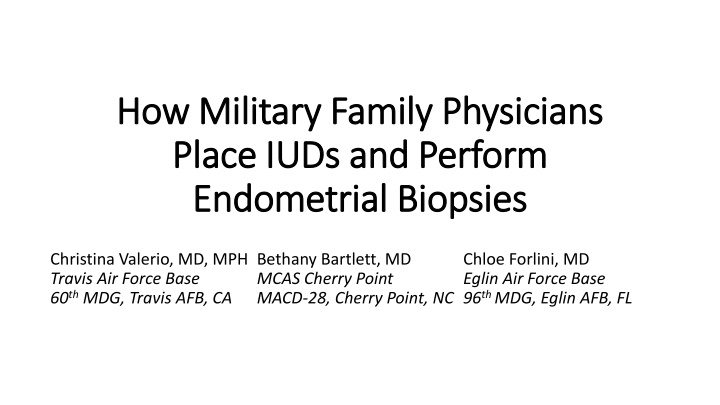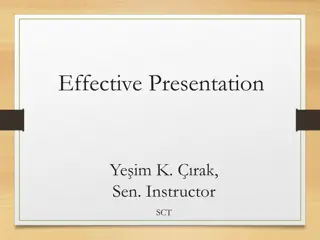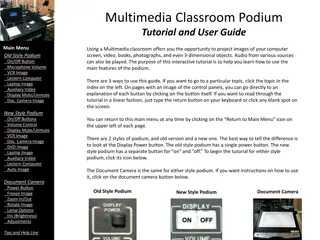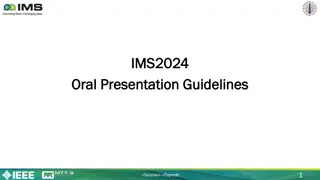
Military Family Physicians: IUD Placement and Endometrial Biopsies Study
Explore how military family physicians at various bases perform IUD placements and endometrial biopsies, analyzing analgesic strategies, procedural techniques, and the use of anxiolytics. The study investigates variations based on gender, practice experience, and learning sources through a cross-sectional survey of USAFP members.
Download Presentation

Please find below an Image/Link to download the presentation.
The content on the website is provided AS IS for your information and personal use only. It may not be sold, licensed, or shared on other websites without obtaining consent from the author. If you encounter any issues during the download, it is possible that the publisher has removed the file from their server.
You are allowed to download the files provided on this website for personal or commercial use, subject to the condition that they are used lawfully. All files are the property of their respective owners.
The content on the website is provided AS IS for your information and personal use only. It may not be sold, licensed, or shared on other websites without obtaining consent from the author.
E N D
Presentation Transcript
How Military Family Physicians How Military Family Physicians Place IUDs and Perform Place IUDs and Perform Endometrial Biopsies Endometrial Biopsies Christina Valerio, MD, MPH Travis Air Force Base 60thMDG, Travis AFB, CA Bethany Bartlett, MD MCAS Cherry Point MACD-28, Cherry Point, NC Chloe Forlini, MD Eglin Air Force Base 96th MDG, Eglin AFB, FL
Disclosure The views and statements in the presentation are solely from the investigators. They do not represent the opinions or positions of the Department of Defense or the United States Air Force. The investigators have no financial disclosures.
Analgesic Strategies NSAIDs Topical Anesthetics Anxiolytics Consensus from small randomized controlled trials
Procedural Techniques Tenaculum Bimanual Exam Misoprostol Consensus from small randomized controlled trials
Primary Objective: What techniques do military family physicians use when performing endocervical procedures?
Secondary Objectives: Do analgesic techniques and procedural steps vary amongst military family physicians depending on gender and time in practice? What is the main source of learned techniques?
Cross-sectional survey (Omnibus Survey) Survey sent out to all USAFP members Demographic information multiple-choice and fill-in format 10 multiple-choice questions
Prior to an IUD insertion or endometrial biopsy, what do you use for pain control? Prior to an IUD insertion or endometrial biopsy, do you give anxiolytics? a. Always a. NSAID use prior b. Sometimes b. Topical anesthetic c. Rarely c. Vary based on patient d. Never d. N/A I do not perform these procedures e. N/A - I do not perform these procedures
Methods -Descriptive statistics and chi-square analysis
Results Results
IUD INSERTION AND PAIN CONTROL Frequency Percent IUD and Pre-procedural NSAIDs 54 30.9 No NSAID prior 121 69.1 NSAID prior 175 100.0 TOTAL IUD and Topical Anesthetic 166 94.9 No topical anesthetic 9 5.1 Topical anesthetic 175 100.0 TOTAL
IUD INSERTION AND PAIN CONTROL Frequency Percent IUD and Pre-procedural NSAIDs 54 30.9 No NSAID prior 121 69.1 NSAID prior 175 100.0 TOTAL IUD and Topical Anesthetic 166 94.9 No topical anesthetic 9 5.1 Topical anesthetic 175 100.0 TOTAL
ANXIOLYTIC USE FOR ENDOCERVICAL PROCEDURES Frequency Percent May give anxiolytic 90 51.4 Never give anxiolytic 85 48.6 Total 175 100.0
ANXIOLYTIC USE FOR ENDOCERVICAL PROCEDURES Frequency Percent May give anxiolytic 90 51.4 Never give anxiolytic 85 48.6 Total 175 100.0
MISOPROSTOL USE FOR ENDOCERVICAL PROCEDURES Frequency Percent May give misoprostol 78 44.6 Never give misoprostol 97 55.4 Total 175 100.0
MISOPROSTOL USE FOR ENDOCERVICAL PROCEDURES Frequency Percent May give misoprostol 78 44.6 Never give misoprostol 97 55.4 Total 175 100.0
BIMANUAL EXAM WHEN PERFORMING ENDOCERVICAL PROCEDURES Frequency Percent Don t always perform bimanual 125 71.4 Always perform bimanual 50 28.6 Total 175 100.0
BIMANUAL EXAM WHEN PERFORMING ENDOCERVICAL PROCEDURES Frequency Percent Don t always perform bimanual 125 71.4 Always perform bimanual 50 28.6 Total 175 100.0
USE OF TENACULUM WHEN PERFORMING ENDOCERVICAL PROCEDURES Frequency Percent Don t always use tenaculum Always use tenaculum 133 76.0 42 24.0 Total 175 100.0
USE OF TENACULUM WHEN PERFORMING ENDOCERVICAL PROCEDURES Frequency Percent Don t always use tenaculum 133 76.0 Always use tenaculum 42 24.0 Total 175 100.0
REPORTED GENDER AND NSAID USE IUD: Pre-procedural NSAID Total No NSAID prior NSAID prior Female 19 64 83 Not Female 35 57 92 Total 54 121 175 p=0.030
REPORTED GENDER AND NSAID USE IUD: Pre-procedural NSAID Total No NSAID prior NSAID prior Female 19 64 83 Not Female 35 57 92 Total 54 121 175 p=0.030
TIME FROM RESIDENCY GRADUATION AND BIMANUAL EXAM PERFORMED Bimanual Exam Performed Don't always perform bimanual Total Always perform bimanual Time from Residency: 5 years or less 77 16 93 Time from Residency: > 5 years Total 48 34 82 125 50 175 p=0.000
TIME FROM RESIDENCY GRADUATION AND BIMANUAL EXAM PERFORMED Bimanual Exam Performed Don't always perform bimanual Total Always perform bimanual Time from Residency: 5 years or less 77 16 93 Time from Residency: > 5 years 48 34 82 Total 125 50 175 p=0.000
Source of Learned Behavior Medical School Faculty Residency Faculty Colleague Literature Manufacturer
SOURCE OF LEARNED BEHAVIORS FOR ENDOCERVICAL PROCEDURES Residency Faculty No 2 1.1 98.9 Yes 173 Total 175 100.0
Discussion Discussion
Discussion Family physicians rarely use topical anesthetics Significant results with gender and time from residency graduation Most procedures and techniques are learned from residency faculty
Limitations Low response rate (11.1%) Possibility of selection bias with low response rate Phrasing/verbiage of questions in cross-sectional surveys
Future Research Dose and timing of NSAIDs to best improve procedural pain Dose, timing, and method of administration of topical lidocaine to best improve procedural pain Efficacy of misoprostol in patients with cervical stenosis Expulsion and perforation rate of IUD insertion with/without tenaculum use
Conclusion Military FM Physician practice patterns for endocervical procedures do not always align with current analgesic strategies or procedural techniques suggested by the limited amount of literature The majority of physicians reported learning their procedural techniques from residency, suggesting this may be the most beneficial population to target when teaching/implementing practice guidelines
References 1. Guzel AI, Kuyumcuoglu U, Celik K. Comparative effect of lornoxicam and paracetamol in pain relief in endometrial sampling. J Exp Ther Oncol. 2012; 9 (4): 317-20. 2. Somchit W. Lertkhachonsuk AA, Vallipakorn SA. Naproxen for pain relief during endometrial biopsy: a randomized controlled trial. J Med Assoc Thai. 2015; 98 (7): 631-5. 3. Hillard, Paula J. Adams. Practical Tips for Intrauterine Device Counseling, Insertion, and Pain Relief in Adolescents: An Update. Journal of Pediatric and Adolescent Gynecology, Volume 32, Issue 5, S14 - S22 4. Lopez LM, Bernholc M, Zeng Y, Allen RH, Bartx D, O Brien PA, Hubacher D. Interventions for pain with intrauterine device insertion. Cochrane Database Syst Rev. 2015 Jul 29;(7). 5. Einarsson JI, Henao G, Young AE. Topical analgesia for endometrial biopsy a randomized controlled trial. Obstet Gynecol. 2005; 106 (1): 128-130. 6. Aksoy U, Aksoy S, Ozyurt S, et al. Effect of lidocaine spray in pain management during office-based endometrial sampling: a randomized placebo controlled trial. J Obstet Gynaecol. 2016; 36(2): 244-250. 7. Luangtangvarodom W, Pongrojpaw D et al. The efficacy of Lidocaine spray in pain relief during outpatient- endometrial sampling: a randomized placebo-control trial. Pain Res Treat. 2018; 2018. 1238627. 8. Karaca I, Yapca OE et al. Effect of cervical lidocaine gel for pain relief in Pipelle endometrial sampling. Eurasian J Med. 2016; 48 (3): 189-91.
References cont. 9. Abbas A, Samy A, et al. Medications for pain relief in outpatient endometrial sampling or biopsy: a systematic review and network meta-analysis. Fertil Steril. 2019; 112 (1): 140-148.e12. 10. Allen RH, Micks E, Edelman A. Pain relief for obstetric and gynecologic ambulatory procedures. Obstet Gynecol Clin North Am. 2013 Dec;40(4):625-45. 11. Matthews LR1, O Dwyer L, O Neill E. Obstet Gynecol. Intrauterine Device Insertion Failure After Misoprostol Administration: A Systematic Review. 2016 Nov;128(5):1084-1091. 12. Perrone JF, Caldito G, et al, Ford WR, London SN. Oral misoprostol before office endometrial biopsy. Obstet Gynecol. 2002; 99 (3): 439-444. 13. Crane JMG, Craig C, Dawson L, O Grady T, Bartellas E, Hutchens D. Randomized trial of oral misoprostol before endometrial biopsy. J Obstet Gynaecol Can. 2009; 31 (11): 1054-1059. 14. Gulec UK, Khatib G, Guzel AB, Akil A, UrunsakIF, Ozgunen FT. The necessity of using tenaculum for endometrial sampling procedure with pipelle: a randomized controlled study. Arch Gynecol Obstet. 2014; 289: 349-356. 15. Johnson, BA. Insertion and Removal of Intrauterine Devices. American Family Physician. 2005 Jan 1;71(1):95- 102. 16. Christenson K, Lerma K, Shaw KA, Blumenthal PD Assessment of a simplified insertion technique for intrauterine devices.Int J Gynaecol Obstet. 2016 Jul;134(1):29-32.



















